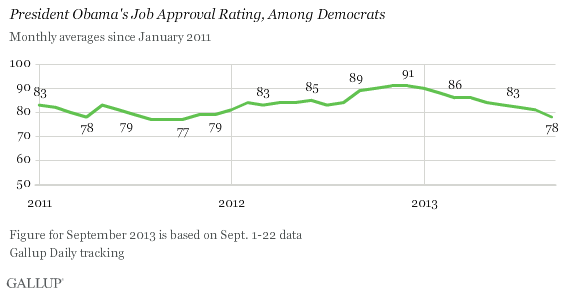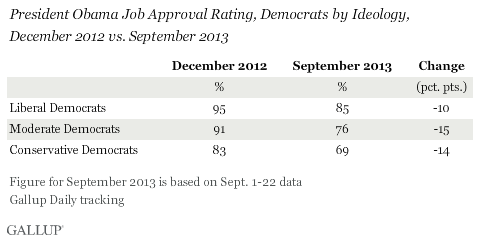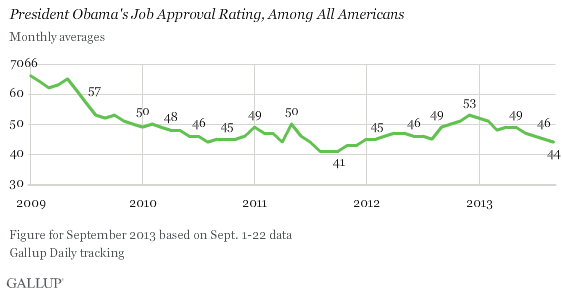PRINCETON, NJ -- Barack Obama's job approval rating among Democrats, his core supporters, has averaged 78% so far in September after being at or above 80% each month since December 2011, including a recent high of 91% in December 2012.

The 13-percentage-point decline in Democrats' approval rating for the president since last December exceeds the nine-point drop, from 53% to 44%, among all U.S. adults over the same time.
Democrats' approval rating of Obama has either declined or held steady each month this year. It last showed an increase in November 2012.
Obama's low point for monthly approval among Democrats is 77%, which he averaged from August through October 2011. Coincidentally, that was the last time the president and Congress tangled over the U.S. debt limit, similar to the scenario playing out in Washington today. The United States is set to default on its debt obligations as early as next month unless Congress passes a law to increase the amount the U.S. can legally borrow.
In addition to the debt limit issue, a fight with Congress looms over the budget as the new fiscal year is poised to start on Oct. 1 and no agreement on a new budget or a continuing resolution is imminent. Obama's handling of the situation in Syria may also be contributing to his lower approval ratings this month.
Obama's approval rating is down at least 10 percentage points from December's recent high among Democrats of all ideological viewpoints, including 10 points among liberal Democrats, 15 points among moderate Democrats, and 14 points among conservative Democrats. Liberal Democrats remain the most supportive of the president at 85%, followed by moderate Democrats at 76% and conservative Democrats at 69%.

President Also Losing Ground Among Independents
The president's approval rating is also down among independents to 37% so far this month, compared with 39% in August. Independents' ratings have not shown the same consistent downward trend as Democrats' ratings this year, with increases in April, May, and August.

Twelve percent of Republicans currently approve of the job Obama is doing in September to date, unchanged from the last two months. Republicans' approval ratings of Obama have been steady this year, ranging between 11% and 13% in all but one month (14% in May).
Obama Approval Poised to Drop for Fourth Month in a Row
Overall, 44% of Americans approve of the job Obama is doing in September to date. Obama averaged 45% approval in August, and his rating has dropped at least one percentage point each month since June. His approval remains above the 41% he received from August through October 2011, his lowest monthly averages.

Obama has averaged a middling 49% job approval as president. His initially high ratings descended to the 50% level by the end of his first year in office, and his ratings were generally in the mid- to high 40s during his second year. His third year bought a brief spike after the U.S. killing of Osama bin Laden in May, but that was followed by a sharp decline later that year after the debt ceiling was raised.
Obama's approval rating improved during his re-election year, with a jump after the Democratic convention in September, and it continued to rise, to 53% in December, after he won a second term. His fifth-year approval ratings have shown a steady downward trend and are back in the mid-40% range.
Implications
Loss of support from a president's core supporters is an ominous sign, as they are typically the last group to abandon the president when things go sour. Obama still enjoys the support of the vast majority of Democrats, 78%, but that is down 13 points from the end of last year and is six points below his average 84% approval rating from Democrats throughout his presidency.
Obama's ability to reach agreement with a recalcitrant Republican House majority on the budget and federal debt limit may go a long way toward determining whether he can regain support among Democrats, and among Americans more generally.
Explore President Obama's approval ratings in depth and compare them with those of past presidents in the Gallup Presidential Job Approval Center.
Survey Methods
Results for this Gallup poll are based on telephone interviews conducted Sept. 1-22, 2013, on the Gallup Daily tracking survey, with a random sample of 11,259 adults, aged 18 and older, living in all 50 U.S. states and the District of Columbia.
For results based on the total sample of national adults, one can say with 95% confidence that the margin of sampling error is ±1 percentage points.
For results based on the total samples of 3,417 Democrats, 4,337 independents, and 3,131 Republicans, one can say with 95% confidence that the margin of sampling error is ±2 percentage points.
Interviews are conducted with respondents on landline telephones and cellular phones, with interviews conducted in Spanish for respondents who are primarily Spanish-speaking. Each sample of national adults includes a minimum quota of 50% cellphone respondents and 50% landline respondents, with additional minimum quotas by region. Landline and cell telephone numbers are selected using random-digit-dial methods. Landline respondents are chosen at random within each household on the basis of which member had the most recent birthday.
Samples are weighted to correct for unequal selection probability, nonresponse, and double coverage of landline and cell users in the two sampling frames. They are also weighted to match the national demographics of gender, age, race, Hispanic ethnicity, education, region, population density, and phone status (cellphone only/landline only/both, and cellphone mostly). Demographic weighting targets are based on the March 2012 Current Population Survey figures for the aged 18 and older U.S. population. Phone status targets are based on the July-December 2011 National Health Interview Survey. Population density targets are based on the 2010 census. All reported margins of sampling error include the computed design effects for weighting.
In addition to sampling error, question wording and practical difficulties in conducting surveys can introduce error or bias into the findings of public opinion polls.
For more details on Gallup's polling methodology, visit www.gallup.com.
